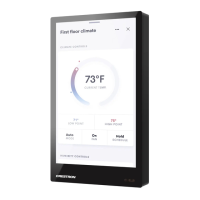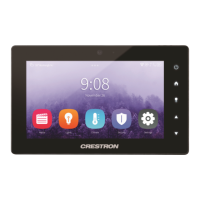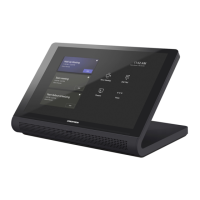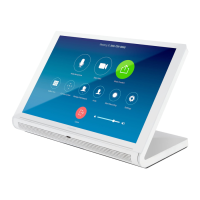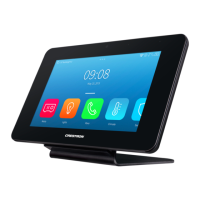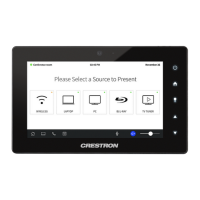
Do you have a question about the Crestron TSW-560 and is the answer not in the manual?
| Resolution | 800 x 480 pixels |
|---|---|
| Touch Technology | Capacitive |
| Ethernet | 10/100 Mbps |
| Power over Ethernet (PoE) | Yes |
| Operating System | Crestron OS |
| Audio Output | Built-in speaker |
| Connectivity | Ethernet, USB |
| Processor | Quad Core |
| Memory | 2 GB |
| Mounting | Wall or table mount |
| Power Supply | PoE or external power supply |
Configure wired network settings, including IP address and DHCP.
View and edit IP table settings for control system connections.
Adjust master volume, media volume, and beep volume settings.
Configure LCD and key backlight brightness and auto-brightness settings.
Set the duration before the screen enters standby mode.
Select the primary application to run on the touch screen.
Access diagnostic tests and view system information like CPU temp.
Display color bars, vertical lines, grid pattern, or test pattern.
Test the touch screen's responsiveness and accuracy.
Test the real-time streaming protocol (RTSP) for video sources.
Test the Ethernet connection and ping the default router.
Test the functionality of the capacitive hard keys on the screen.
Configure and test the Rava SIP intercom functionality.
Perform a test of the built-in microphones.
View firmware, UI, and OS version information.
Restart the touch screen.
Reset touch screen configuration settings to default values.
Manually upgrade the touch screen firmware using a PUF file.
Download touch screen message logs for diagnostic purposes.
Manage installed certificates for security.
Force the touch screen to enter its built-in setup interface.
Force the touch screen to enter standby mode.
Save any modifications made to the configuration settings.
Revert touch screen settings to the last saved configuration.
Upload a custom user project to the touch screen.
Update the currently selected application.
View the status of device, network, and control system settings.
View general device information such as model and serial number.
View the status of network settings like IP address and hostname.
View the status of connected USB accessories.
View the status of the room when using a scheduling application.
View the current status of the display.
View the status of a connected control system.
Configure various touch screen settings and select applications.
Configure general network and touch screen settings.
Configure network proxy settings for HTTP and HTTPS.
Configure panel volume, media volume, and beep volume settings.
Enable or disable connection to an XiO Cloud service account.
Configure date, time, and time synchronization settings.
Configure user authentication and access levels.
Configure IEEE 802.1x network authentication for security.
Configure automatic firmware updates for the touch screen.
Select and set up applications to run on the touch screen.
Set up the Crestron room scheduling application.
Set up the Crestron Home user control application.
Set up the Appspace digital signage application.
Set up the AskCody room scheduling application.
Set up the EMS Software scheduling application.
Set up the Gingco.net scheduling application.
Set up the Indoor Finders scheduling application.
Set up the Microsoft Teams online meeting solution.
Set up the New Wave Apps scheduling application.
Set up the NFS Rendezvous scheduling application.
Set up the Robin scheduling application.
Set up the Space Connect scheduling application.
Set up the SpaceIQ scheduling application.
Set up the Teem scheduling application.
Set up Zoom Rooms conferencing control or scheduling.
Configure settings for pairing the touch screen to a CEN-ODT-C-POE.
Configure a connection to a Crestron control system.
Claim a single device to the XiO Cloud service.
Claim multiple devices using a CSV file.

